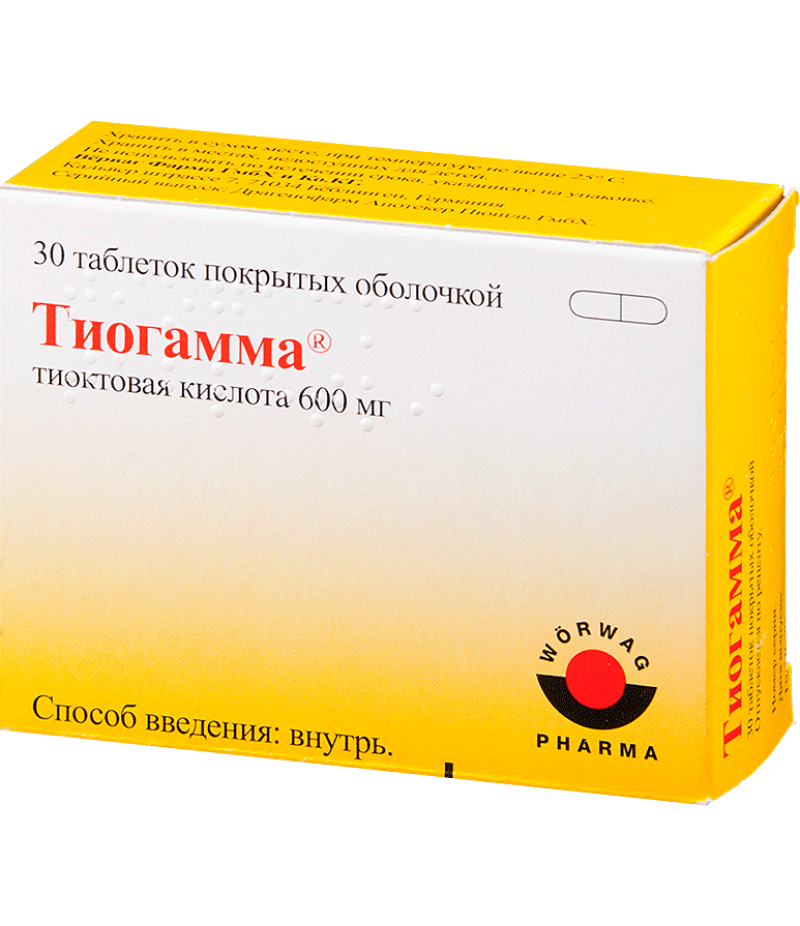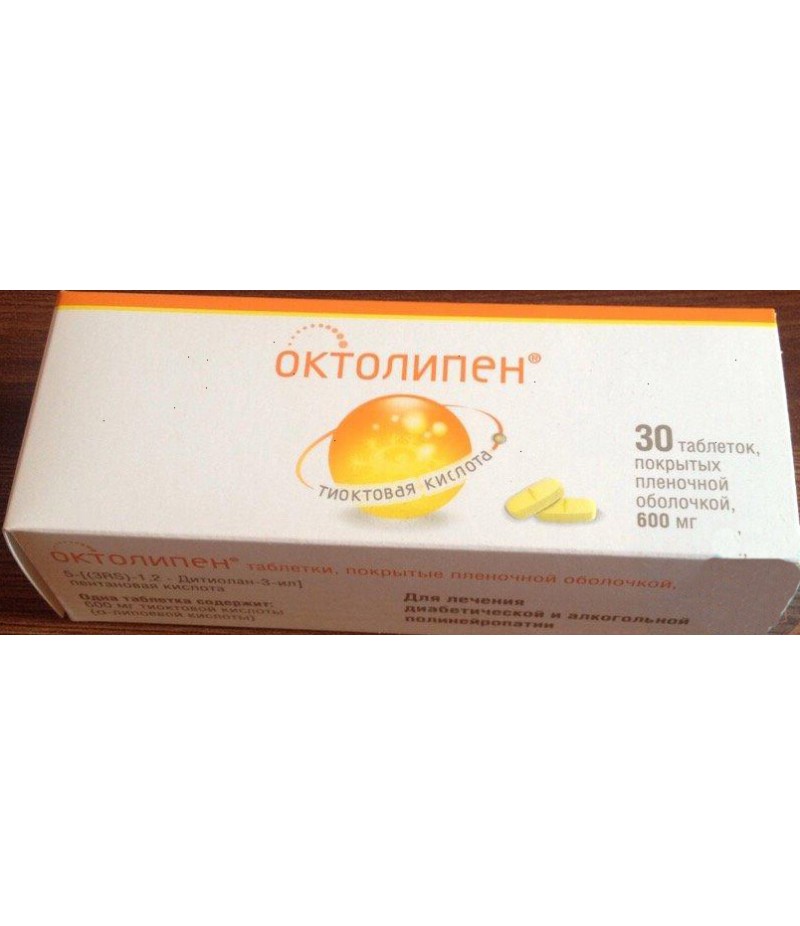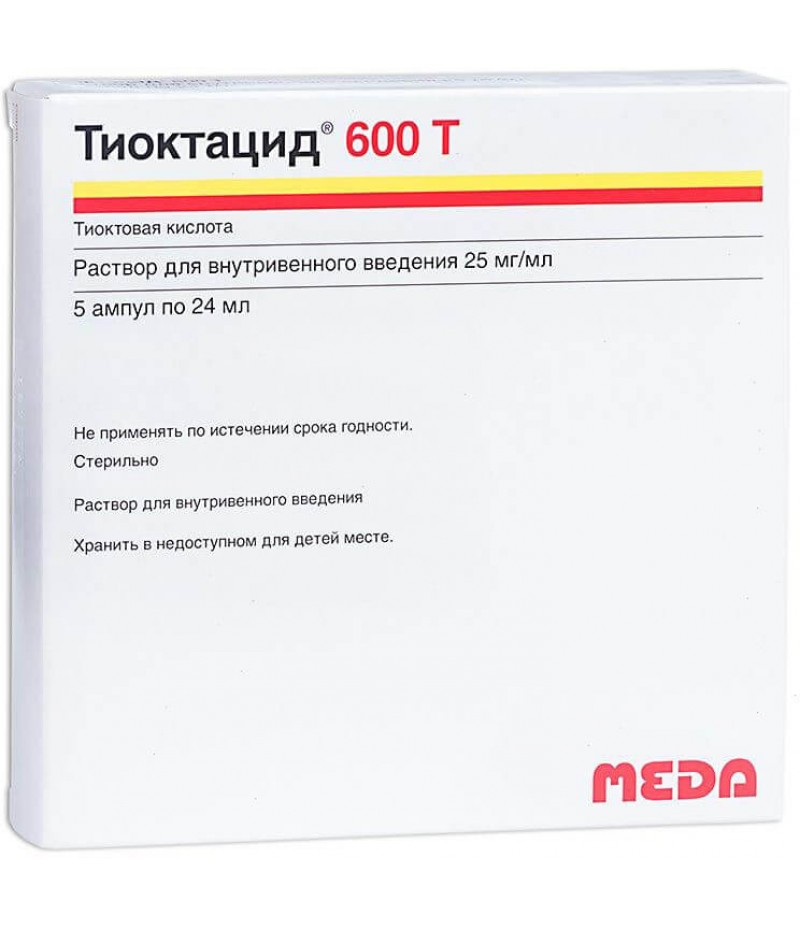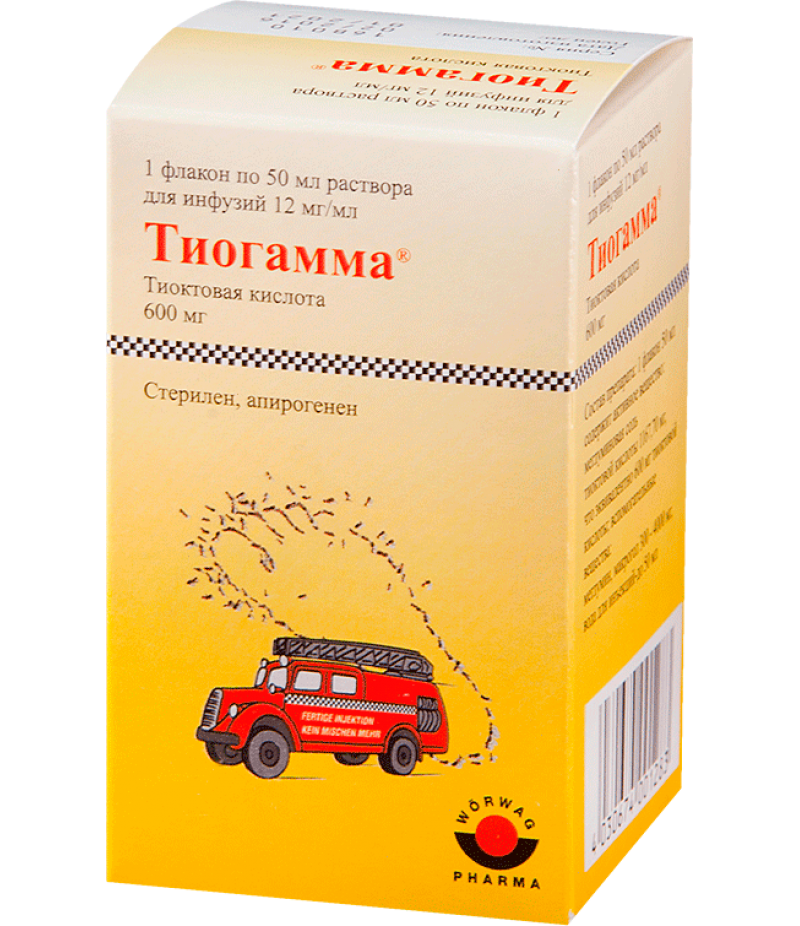Thiogamma tabs 600mg #30
- $49.99
- 2 or more $48.50
- 3 or more $47.99
- Availability:In Stock
Thiogamma instruction for useReed more and buy Thiogamma hereCompositionConcentrate for the preparation of the solution consists of the following components: meglumine tioktat (acts as the main active substance) ..
Tags: tabs
Thiogamma instruction for use
Reed more and buy Thiogamma here
Composition
Concentrate for the preparation of the solution consists of the following components:
meglumine tioktat (acts as the main active substance) - 1167.7 mg (in the mass conversion corresponds to 600 mg of thioctic acid);
macrogol 300 - 4000 mg;
meglumine - 6-18 mg;
purified water for injection - up to 20 ml.
The solution for infusions has such components as:
meglumine salt of thioctic acid - 1167.7 mg (corresponding to 600 mg of thioctic acid in the dry residue);
macrogol 300 - 4000 mg;
meglumine;
water for injection - up to 50 ml.
Tablets contain:
tiectic acid - 600 mg;
microcrystalline cellulose (MCC) - 49 mg;
lactose monohydrate - 49 mg;
talc - 36, 364 mg;
hypromellose - 25 mg;
colloidal silicon dioxide - 25 mg;
sodium carmellose - 16 mg;
magnesium stearate - 16 mg;
simethicone - 3,636 mg (the necessary ratio of dimethicone and colloidal silicon dioxide is 94: 6).
The shell of each pill consists of:
hypromellose - 2.8 mg;
talcum - 2 mg;
macrogol 6000 - 0.6 mg;
sodium lauryl sulfate - 0.025 mg.
Form of issue
In pharmacy kiosks, the pharmaceutical product is supplied in the following variations:
Transparent concentrate for the preparation of infusion solution in ampoules of 20 ml each of yellow or greenish-yellow color. Ampoules are made of brown glass type I, each marked with a white paint in the form of a dot. The cardboard tray with separators for the sections contains 5 ampoules. The pack consists of 1, 2 or 4 plates and a pendant case providing a light protection, which is made of black PE.
Ready transparent solution for infusion of light yellow color or with a green tint, 50 ml each in cinnamon glass type II bottles, each of which is closed with a rubber stopper. The latter are fixed to the bottle using aluminum caps with a polypropylene gasket on the top. In a pack are placed on 1 or 10 bottles, separated by cardboard partitions, complete with hanging light-protective cases in the number of bottles.
Oblong and biconvex tablets of 600 mg are packed in PVC or aluminum foil blisters of 10 pieces each. Tablets are light yellow with impregnations of white and yellow color of varying intensity. On both surfaces there are characteristic risks. The cross section shows the core of the tablet also in light yellow color, covered with a dense shell. A cardboard box, as a rule, holds 3, 6 or 10 contour plates.
Pharmacological action
The main active ingredient of the pharmaceutical preparation Thiogamma, regardless of the form of release, is tioktovaya or alpha-lipoic acid (two names of the same biologically active substance). This is a natural part of metabolism, that is, normally this acid is formed in the body and acts as a coenzyme of the mitochondrial complexes of the energy metabolism of pyruvic acid and alpha-keto acids along the oxidative decarboxylation pathway. Also, Thioctic acid is an endogenous antioxidant, since it is capable of binding free radicals and protecting cells from their destructive effects in this way.
Important role of the constituent part of the drug and for carbohydrate metabolism. It promotes the reduction of free circulating glucose in the blood serum and the accumulation of glycogen in the liver cells. Due to this property, thiectic acid reduces the insulin resistance of cells, that is, the physiological response to this hormone is more active.
Participates in the regulation of lipid metabolism. Particularly noticeable is the effect of the active substance on the cholesterol metabolism as a cholesterol-lowering agent - the acid reduces the circulation of lipids of low and very low density and increases the percentage of high-density lipids in the blood serum). That is, Thioctic acid has a certain anti-atherogenic property and clears the micro- and macrocirculatory bed from the excess of fats.
The detoxification effects of the pharmaceutical preparation are also noticeable in heavy metal poisoning and other intoxication. This action is developed by activating the processes in the liver, which improves its function. However, Thioctic acid does not contribute to the exhaustion of its physiological reserves, and even on the contrary has strong hepatoprotective properties.
It should be noted that drugs based on Alpha-lipoic acid are actively used in diabetes mellitus, since the constituent components help to reduce the formation of final glycation metabolites and increase the glutathione content to physiologically normal parameters. The trophism of the nerves and endoneural blood flow also improve, which leads to a generalized qualitative increase in the state of the peripheral nerve fibers and prevents the development of diabetic polyneuropathy (the nosological unit that develops due to damage to the nerve pillars by the increased concentration of glucose and its metabolites).
Due to its pharmacological properties (hepato- and neuroprotective, detoxifying, antioxidant, hypoglycemic and many others), thioctic acid is similar to Group B vitamins.
Thioktova or alpha-lipoic acid has gained wide popularity in cosmetology due to the following pharmacological action on the face skin, the care of which is usually given is not easy:
removes hypersensitivity;
tightening skin folds, reduces the depth of wrinkles, making them invisible, even in such difficult areas as the corners of the eyes and lips;
heals traces of acne (acne) and scars, since, penetrating into the intercellular substance, it stimulates the normal operation of the reparative mechanisms;
narrows the pores on the face and regulates the functional ability of the sebaceous glands, thus eliminating the problems of oily or greasy skin;
acts as a powerful antioxidant of endogenous origin.
Pharmacodynamics and pharmacokinetics
When taken orally, the drug is quickly and completely absorbed from the gastrointestinal tract. It should be noted that the simultaneous use of the drug with food intake reduces the degree of absorption of Thiogamma. After the first passage through the liver, a significant part of the active component undergoes irreversible changes (in the pharmacological literature this phenomenon is described as the effect of the first passage), therefore the bioavailability of the drug is 30 to 60 percent, depending on the individual metabolic abilities of the organism. The maximum plasma concentration is about 4 μg / ml with a delivery period of 30 minutes.
Thiogamma for droppers or preparation of infusion solutions is administered intravenously, because the pharmaceutical preparation in this form of release can avoid the effect of the effect of the first passage. The period of delivery to the systemic circulation is about 10-11 minutes, and the maximum plasma concentration in this case is 20 μg / ml.
The drug is metabolized, regardless of the form used, in the liver by side chain oxidation and further conjugation. Plasma clearance - 10-15 ml / min. Thioctic acid and its metabolites are excreted mainly by the kidneys (about 80-90 percent). In urine, a small amount of unchanged constituents of the pharmaceutical preparation is found. The half-life of Tiogammum 600 (the figure 600 indicates the mass content of Alpha-lipoic acid in terms of the dry residue) is 25 minutes, and the enhanced form of the drug, called Thiogamma Turbo, is 10 to 20 minutes.
Indications for use
diabetic neuropathy;
alcoholic damage to nerve trunks;
liver diseases - hepatitis and cirrhosis of various origin, fatty degeneration of hepatocytes;
peripheral or sensory-motor polyneuropathy;
intoxication with strong manifestations (for example, heavy metal salts or fungi).
Contraindications
acquired or hereditary intolerance of the constituent components of the pharmaceutical preparation;
childhood;
period of pregnancy and breastfeeding;
severe impairment of kidney or liver function (especially jaundice of any origin);
acute period of myocardial infarction;
decompensated stages of cardiovascular or respiratory failure;
Stomach ulcer or severe hyperacid gastritis;
dehydration and exsicosis;
chronic alcoholism;
decompensated form of diabetes mellitus;
acute disorders of cerebral circulation;
predisposition to the development of lactic acidosis (in particular for the forms of the drug intended for parenteral administration);
Glucose-galactose malabsorption for tablets.
Side effects
When treating with a pharmaceutical product, the following undesirable consequences can be observed:
From the coagulation system: spot hemorrhages in the form of purpura (hemorrhagic rash), thrombophlebitis, thrombocytopenia.
From the nervous system: dizziness, headache, increased sweating, rarely - convulsive twitching of individual muscles.
On the part of metabolic processes: disturbance of the visual apparatus due to hypoglycemic conditions (decrease in the concentration of free glucose in the blood serum), which is mainly manifested in the form of diplopia.
The digestive tract (for tablets Thiogamma and Thiogamma Turbo for parenteral administration): dyspeptic disorder, rarely - a violation of the sensitivity of the flavoring apparatus.
Local reactions: local redness, eczema or urticaria at the injection site.
With an unreasonably rapid intravenous administration of a drug - increased intracranial pressure and a respiratory cycle disorder (dyspnea).
Others - allergic conditions up to anaphylactic shock.
Thiogamma, instructions for use (Method and dosage)
Instructions for use Thiogamma varies considerably depending on the pharmaceutical form of the drug used.
Tablets 600 mg are applied orally, once a day. Do not chew them, as it can damage the shell, it is recommended to drink a small amount of water. The duration of the course is determined individually by the attending physician, because it depends on the degree of the disease. Usually pills are taken from 30 to 60 days. A repetition of the course of conservative therapy is possible 2-3 times a year.
Thiogamma Turbo is used for parenteral administration by intravenous drip infusions. The daily dosage is 600 mg once a day - calculated on the contents of a single vial or ampoule. The introduction is done slowly, for 20-30 minutes, in order to avoid side effects from rapid infusion of the drug. The course of therapy of this form of the drug is from 2 to 4 weeks (a shorter duration of conservative treatment is due to higher maximum plasma concentrations after parenteral administration of the drug).
Concentrate for the preparation of intravenous infusions is used as follows: the contents of 1 ampoule (in terms of the main active ingredient - 600 mg of thioctic acid) are mixed with 50-250 isotonic (0.9 percent) sodium chloride solution. Immediately after preparation of the medicinal mixture, the vial is covered with a light-protecting case (there is a mandatory one in the preparation of the preparation at the rate of one case per one vial of the drug). Immediately, the solution is administered by intravenous drip infusion for 20-30 minutes. The maximum period of storage of the prepared Thiogamma solution is no more than 6 hours.
Thiogamma can be used for skin care. For this, a pharmaceutical form for droppers in vials is used (ampoules with concentrate for the preparation of intravenous infusions are not suitable as a cosmetic agent, since they can cause allergic reactions due to a large amount of the active component). The contents of one bottle are applied in a pure form on the whole surface of the face skin twice a day - in the morning and in the evening. Before such manipulation it is recommended to wash with warm, soapy water, in order to clean the entrance gate of pores for deep penetration of thioctic acid.
Overdose
With an excessive concentration of the active components of a pharmaceutical preparation in blood plasma, the following can be observed:
increased side effects;
intense headache;
profuse vomiting and not passing nausea;
psychomotor agitation;
impaired consciousness;
epileptic seizures or generalized convulsions;
lactic acidosis;
hypoglycemic coma;
acute circulatory failure - shock;
syndrome of disseminated intravascular coagulation;
bone marrow depression;
multiple organ failure.
There is no specific antagonist for the drug, so the overdose state is symptomatically stopped. If the drug was used in the form of tablets, it is recommended to rinse the stomach, enter enterosorbents (for example, activated charcoal from the mass of the patient) and medically induce vomiting as soon as possible after administration.
If parenteral administration of a pharmaceutical preparation is used, then actions such as the administration of analgesics are shown in order to stop the headache and other drugs in order to facilitate the patient's condition as much as possible. Treatment of generalized epileptic seizures, lactic acidosis or other pathological conditions that directly threaten life is performed according to modern intensive care protocols.
Interaction
When combined therapy, which involves the simultaneous use of thiectic acid and cisplatin, significantly reduces the effectiveness of the latter.
Preparations containing metal ions (for example, based on iron) do not exert their therapeutic effect, since the active component of Thiogamma binds metals and safely removes them from the body.
Increases the anti-inflammatory effect of glucocorticoid steroids when they are used together with thioctic acid in a conservative therapy regimen.
Combined use of oral hypoglycemic agents and insulin against the background of Thiogamma treatment enhances the therapeutic effects of antidiabetic drugs, therefore, when taking Alfa-lipoic acid in patients with diabetes mellitus, the course of sanitizing diabetes should be adjusted accordingly.
Ethanol and its metabolic products weaken the pharmacological action of alpha-lipoic acid, promote the development or further progression of neuropathic diseases, so the use of alcoholic beverages during treatment with this drug is not recommended.
For Thiogamma concentrate and other pharmaceutical forms of the drug there is an additional list of interactions:
Incompatible use of thiectic acid with solutions of Dextrose, crystalloid Ringer's solution or agents connecting disulfide or sulfhydryl groups.
Sugar molecules (for example, from Levulevy or Fructose solutions) form hardly soluble complexes with the main constituent of Thiogamma.
Storage conditions
Keep the drug should be in a dry, dark place at a temperature of no higher than 25 degrees Celsius. Also, Thiogamma should not be accessible to children.
Shelf life - 5 years.
special instructions
Pharmaceutical preparation can be used as a cosmetic means for skin care of the face. Active components have powerful antioxidant properties and no less strong tonic effect, because Thiogamma for the face has gained wide popularity in conservative cosmetology as a tightening tonic. How to use Thiogamma for skin peeling can be found in the instructions for the drug.
The treatment with this pharmaceutical product does not affect the ability to concentrate or for long periods of diligent attention, because driving or working with other complex mechanisms that are potentially life threatening is not prohibited during the course of conservative therapy.
Children
Pharmaceutical preparation is strictly contraindicated for use in pediatric practice, since severe consequences can occur in the form of side effects, which in children are especially difficult to stop.
In pregnancy and lactation
During lactation and pregnancy, the use of the drug is contraindicated because of the possible effects on the child.
Reviews about Thiogamma
Pharmaceutical preparation is very popular in patients with diabetes mellitus or a predisposition to neuropathies. Since Thiogamma provides preventive treatment of diseases of the peripheral nervous system and does not allow you to lose your ability to work for many years. Due to a relatively short course, you can save yourself from the very serious consequences of endocrine pathology.
People who used this medication separately remark that it is not necessary to be afraid of a wide list of side effects, since the degree of their manifestation even according to the pharmaceutical parameters of the World Health Association is classified as very rare (the undesirable effects of treatment appear in less than 1 / 10,000 cases of conservative therapy , including episodic seizures).
Experienced attending physicians and qualified pharmacists are also satisfied with Thiogamma, therefore they use it abundantly in a hospital environment. Due to the effect of the first pass, a possible chance of an overdose or an elevated concentration of active components in the blood plasma is minimized, and the rarely occurring side effects are quickly and easily stopped by medication. Against the background of these facts, the therapeutic properties of the medicinal product really affect, which is a positive opinion even among medical personnel.
As a cosmetic remedy for a person, feedback on Thiogamma confirms the reputation of a medicinal product. Thioctic acid is really able to cope with wrinkles on the most complex areas of the face and is proved by the myriad of thanks on the forums for facial skin care. However, the presence of an allergic skin reaction in persons predisposed to such a reaction (hypersensitivity or hereditary idiosyncrasy) is also noted, therefore it is recommended to conduct an allergic test before using Thiogamma.





